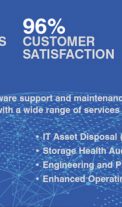In the modern era, companies are faced with many IT challenges in their business environments. Legacy, outdated information technology systems and changing business processes are among these major challenges as companies address legacy system inflexibility, agility, lack of scalability, lack of wider data access, shortage of skills, high cost of maintenance and unreliability. Add this to the fact that there are continually changing technologies, and businesses are faced with the need to assess these new technologies and adapt their infrastructures and applications to leverage those technologies.
For most businesses today, waiting to create a migration strategy is not a viable option. Current business and IT challenges, outdated IT systems and changing business processes require proactive resolution. By empowering the rejuvenation of existing business systems and application uses, migration offers opportunities that both current and future technologies provide. Companies that carefully embrace and incorporate these factors, harness the power of migration and drive the changes that equate to business success, now and in the future.
Before arriving at the decision to migrate, identify why the process should be considered at all. Once you understand that, then you are half way to a successful migration.
Older systems such as mainframes and some software are difficult to integrate with newer technologies. Complex mainframe applications are unable to keep pace with, and respond to, today's dynamic business demands. This presents several issues including:
- Increased maintenance costs of current IT environment
- Limited resources with specialised skill sets
- Lack of interoperability among non-comparable systems
- Lack of scalability and functionality in the current system
- Lack of agility to incorporate new features rapidly.
Protecting long-term investment
Migration sets the stage as a beneficial opportunity to move these old applications into the 21st century and resolve these issues.
Migration enhances and protects the long-term investment in an companies software infrastructure and effectively reduces the total cost of ownership. Performance benchmarking ensures that migrated applications perform better than the old applications, resulting in increased scalability, simplified maintenance, and reduced costs. Development efforts are improved through migration-specific tool creation and use, achieving faster time to market.
Migration can also enable the rejuvenation of existing business systems and leverages application use, offering opportunities that current and future technologies provide.
Migration also enhances the new operating environment. Software assets are consolidated and applications are brought onto a single development platform, resulting in improved system integration, performance, scalability, productivity, integration, reliability, security, and extensibility. In addition, reduced cost overheads are realised by eliminating the need to maintain multiple platforms.
So which strategy do you consider?
Complete migration – Where all of the components in the application are migrated as a whole.
Iterative migration - Allows for a more controlled migration process since the application is migrated component-by-component with each newly migrated component rolled out as a phase.
Limited migration - is different from the iterative migration process in that only a component of the application is migrated. The migrated portion is then modified to interoperate with the un-migrated part of the application.
Vertical migration - differs from the other migrations in that the process is performed tier-by-tier. The developer determines which component of an application has the least interaction with the other components and performs the migration.
Once the migrated application has been completed, you may find that additional business and user needs may be identified and require developer and/or system support. Issues may involve system configuration or optimisation or the application configuration parameters may require fine tuning.
Below is a migration best practice checklist that provides an overview of the steps required to launch and drive a migration plan.
Call 7Tech today if you want to improve technology, the level of integration or need help to create greater control over your systems.
- Establish costs and benefits of the migration in advance
- Evaluate current resources
- Define the scope of the migration
- Start with simple projects initially
- Use applications best suited for the current operating environment “as is”
- Understand how the application is going to be modified
- Analyse the current application
- Ensure a complete understanding of the migration tool that will be used
- Prepare the code being migrated prior to the actual migration ❑ Upgrade module-by-module
- Test each module as it is being upgraded before continuing migration
- Review the upgrade report generated by the migration tool
- Use stored procedures as much as possible
- Use tools like source code analysers and compatibility test tools to identity issues in advance
- Define technical changes needed due to migration
- Write new test cases for the migrated applications to gauge existing functionality along with performance and scalability tests







